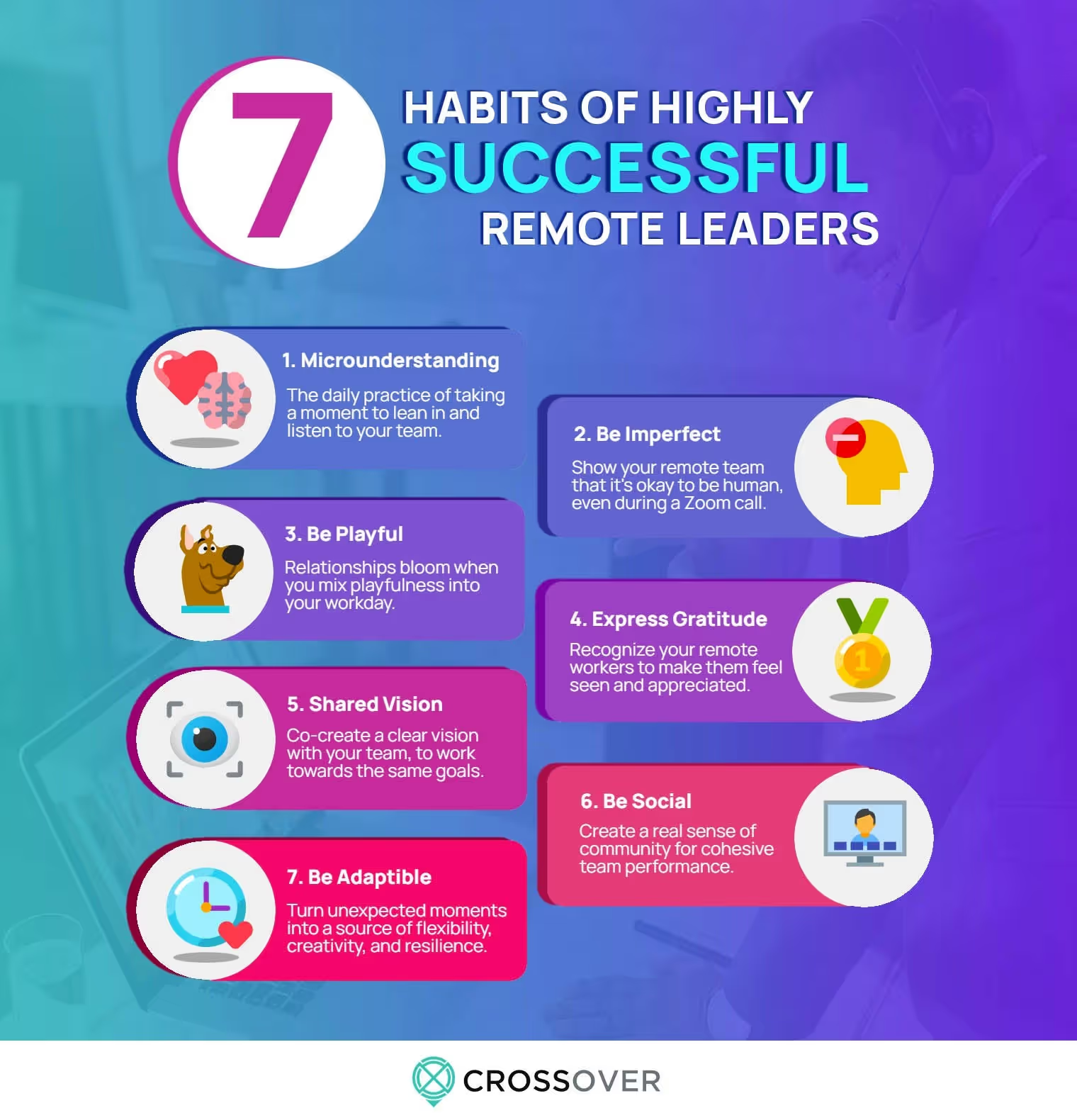Every team of developers, whether it is in-house or remote, requires a great leader. Without a leader, any working team will end up struggling and will eventually enter the phase of absolute chaos. The right leader ensures that the team is working in a collaborative manner, has proper communication with each other, and is able to tackle all sorts of issues to finally be able to deliver the right product on or before the deadline. Simply putting it, a software developer team can simply not exist, at least for long, without a leader. For all the leaders out there, we crafted this blog post that lists the absolute best leadership tips that will enhance your skills in leading a remote team! You can also check out our full guide on how to best manage a remote development team.

Virtual team-building activities are essential to foster a sense of camaraderie among remote team members. These activities can range from online games and quizzes to virtual coffee breaks and collaborative projects. They help to break the monotony of remote work and allow team members to interact in a relaxed environment, which can strengthen relationships and improve communication. Regularly scheduled team-building events ensure that all members feel included and valued, leading to a more cohesive and motivated team.
A comprehensive remote work policy and productivity policy is crucial for setting clear expectations and guidelines for remote employees. You can start implementing this immediately once you hire remote developers. This policy should cover aspects such as working hours, communication protocols, performance metrics, and tools to be used. It should also address issues related to confidentiality, data security, and conflict resolution. By providing a structured framework, a remote work policy helps employees understand their responsibilities and the resources available to them, promoting a more organized and productive work environment.
Leveraging data and analytics is key to making informed decisions when leading a remote team. By tracking metrics such as productivity, engagement, and performance, leaders can gain valuable insights into how their team is functioning. Analytical tools can highlight trends, identify areas for improvement, and measure the impact of implemented strategies. This data-driven approach enables leaders to make strategic decisions that enhance efficiency and support the overall goals of the organization.
Informal interactions are important for building relationships and maintaining a positive team culture when practicing leadership for remote teams. Leaders should encourage casual conversations and social interactions through virtual platforms. This can be achieved by setting up channels for non-work-related discussions, hosting virtual happy hours, or organizing informal catch-up sessions. These interactions help team members to get to know each other on a personal level, fostering a sense of community and reducing feelings of isolation.
Transparency and trust are foundational elements of effective remote leadership. Leaders should openly share information about company goals, challenges, and changes, ensuring that all team members are kept in the loop. Regular updates and open communication build trust and reassure employees that their contributions are valued. Additionally, trusting employees to manage their tasks and schedules without micromanagement demonstrates confidence in their abilities and promotes a culture of accountability and empowerment.
Remote work requires leaders to adapt their management style to address the unique challenges and opportunities it presents. This involves being more flexible, understanding, and supportive. Leaders should focus on outcomes rather than processes, giving employees the autonomy to complete their tasks in ways that suit them best. Active listening, empathy, and regular check-ins are important to ensure that team members feel supported and heard. Adapting leadership style to the remote context helps in maintaining engagement and motivation among employees.
Cybersecurity and data protection are critical in a remote work environment where sensitive information is accessed from various locations. Leaders must implement robust security measures such as encrypted communication, secure access protocols, and regular software updates. Providing training on cybersecurity best practices to employees is also essential to prevent breaches and ensure the safe handling of data. Ensuring strong cybersecurity measures protects the organization’s assets and maintains trust with clients and stakeholders.
Supporting the mental health and well-being of remote employees is vital for maintaining a productive and positive work environment. Leaders should provide access to resources such as counseling services, mental health days, and wellness programs. Encouraging a healthy work-life balance by setting realistic expectations and promoting regular breaks can also help prevent burnout. By prioritizing mental health, leaders demonstrate their commitment to their team’s overall well-being, which can enhance job satisfaction and loyalty.
Diversity and inclusion are essential for fostering a dynamic and innovative remote team. Leaders should actively promote a culture that values different perspectives and backgrounds. This can be achieved by implementing inclusive hiring practices, providing diversity training, and creating forums for open discussions on inclusion. Encouraging diverse viewpoints leads to better decision-making and problem-solving, while an inclusive environment ensures that all team members feel respected and valued.
Encouraging innovation and creativity within a remote team involves creating an environment where ideas can be freely shared and explored. Leaders should provide platforms for brainstorming sessions, collaborative projects, and regular feedback loops. Offering incentives for innovative ideas and recognizing creative contributions can motivate team members to think outside the box. By fostering a culture of creativity, leaders can drive continuous improvement and keep the team engaged and forward-thinking.
At Blue Coding, we strive to offer top-notch IT services to our clients. We focus on nearshore outsourcing in Latin America, with a team of talented developers and IT professionals. Whether you need IT staff augmentation or remote developers for a specific project, Blue Coding is your go-to IT solutions provider. We ensure the security of your company’s data and intellectual property, with our experts available around the clock. Get in touch with us now and book your free strategy call!
Subscribe to our blog and get the latest articles, insights, and industry updates delivered straight to your inbox